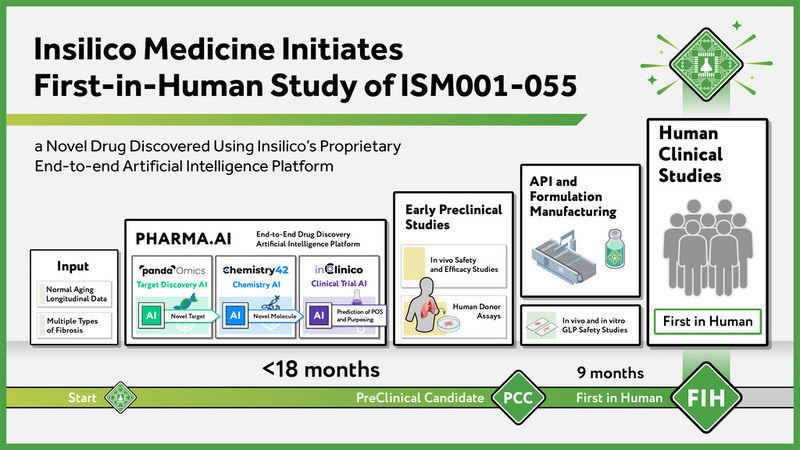Alibaba Develops Memory-Embedded AI Chip; Integration of Convolution and Self-Attention; First-in-Human Study of AI-Discovered Drug
China’s AI news in the week of December 5, 2021
Alibaba Unveils New In-Memory Computing AI Chip
Damo Academy, the research wing of Chinese e-commerce giant Alibaba, claimed to develop the world's first 3D-stacked DRAM-embedded AI chip using hybrid bonding technology. The research result has been accepted in ISSCC 2022, a premium global conference for advanced semiconductor studies.
Damo Academy estimated this new chip architecture will leverage its advantages of high bandwidth and low power consumption in VR/AR, autonomous driving, astronomical data computation, remote sensing image data analysis, and more.
The exponentially rising demand for large-scale, complex AI computation has plagued the existing von Neumann architecture chip architecture, separating computing and data storage. In-memory computing, which refers to information stored on an embedded random access memory of a chip system, promises to unleash data access limitation, significantly speed up data analysis, and reduce energy consumption caused by data communication.
Using 3D hybrid bonding, Damo Academy can directly stack the computing wafer and the memory wafer on top of each other for face-to-face interconnection. In addition, the chip adopted the Stacked Embedded DRAM (SeDRAM) architecture for the memory unit and devised a streamlined, customized accelerator for the computing unit to enable an end-to-end recommendation acceleration.
Damo Academy says that the new chip boasts an increase of performance by more than ten times and better power efficiency by more than 300 times compared to CPUs in the recommendation system. What remains secret about the chip is the release time, the architecture of the computing unit, and the fab.
On the Integration of Self-Attention and Convolution
A team of researchers from Tsinghua University, Huawei, and Beijing Academy of Artificial Intelligence suggested there exists a strong underlying relation between Convolution and Self-Attention, and therefore proposed a mixed model that enjoys the benefit of both self-Attention and Convolution (ACmix), while having minimum computational costs compared to the pure Convolution or self-attention counterpart.
In the paper On the Integration of Self-Attention and Convolution, researchers first studied the connections between Self-Attention, the core element of the Transformer architecture that gives rise to modern NLP models like BERT and GPT-3, and Convolution, the essential part of the Convolution neural networks. They discovered these two paradigms share a similar operation as described below:
Specifically, we first show that a traditional convolution with kernel size k×k can be decomposed into k2 individual 1×1 convolutions, followed by shift and summation operations. Then, we interpret the projections of queries, keys, and values in self-attention module as multiple 1×1 convolutions, followed by the computation of attention weights and aggregation of the values. Therefore, the first stage of both two modules comprises the similar operation.
The new ACmix paradigm for representation combines the merits of self-attention and Convolution. It plays a complementary role in strengthening existing ResNet and Swin Transformer models. Researchers empirically validated ACmix on ImageNet classification, semantic segmentation, and object detection tasks and compared it with state-of-the-art models.
Insilico Medicine Initiates First-in-Human Study of AI-Discovered Drug
Hong Kong-based AI drug discovery company Insilicon Medicine recently kicked off the first-in-human microdose trial of ISM001-055, a novel drug discovered by its AI platform Pharma.AI to treat a chronic lung disease named idiopathic pulmonary fibrosis (IPF). A healthy Australian volunteer has received a micro-dose of the drug.
Founded in 2014, the company took 18 months on a budget of $2.6 million to discover a drug that can address the pulmonary disease through an end-to-end process from target discovery to preclinical candidate nomination. "If you want a new drug, you must find a new target." The company first discovered over 20 disease targets involved in pulmonary disease. Then among 80 molecules that were designed, synthesized, and tested in the human cell and animal models, ISM001-055 was selected and further optimized for another nine months before clinical trials.
Insilico Medicine made the headlines two years ago as it demonstrated its ability to generate drug-like hit molecules using AI for a well-known target in record time. The system, coined the Generative Tensorial Reinforcement Learning (GENTRL) system, was published in Nature Biotechnology.
"We are very pleased to see Insilico Medicine's first antifibrotic drug candidate entering into the clinic. We believe this is a significant milestone in the history of AI-powered drug discovery because to our knowledge the drug candidate is the first-ever AI-discovered novel molecule based on an AI-discovered novel target," said Feng Ren, Ph.D., CSO of Insilico Medicine.
Investment News
ESWIN Technology, a Beijing-based semiconductor products and services supplier, has raised RMB2.5 billion (~$400 million) in its Series C funding round co-led by Gold Stone Investment and China Internet Investment Fund. Founded in 2016, the company develops integrated chips and solutions focusing on mobile devices, smart homes, smart transportation, industrial IoT, and other application scenarios.
Going-Link, a Shanghai-based enterprise services company, has raised RMB650 million (~$102 million) in its Series C funding round. Founded in 2017, the company delivers smart and digital procurement management platforms for over 700 enterprise clients, including Huawei.
FJDynamics, a Guangdong-based robotic company that provides digital and autonomous solutions for agriculture, construction, and other sectors, has raised $70 million in its Series B funding round. Founded in 2017 by former DJI chief scientist, the company aims to make useful and affordable robots for the most labor-intensive industries.




